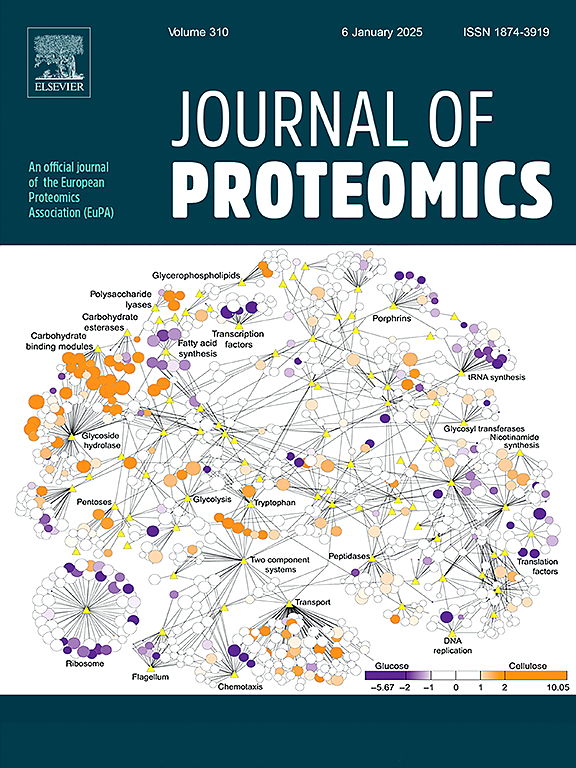Expanded characterization and localization of male seminal fluid proteins within the female reproductive tract of the dengue vector mosquito Aedes aegypti
IF 2.8
2区 生物学
Q2 BIOCHEMICAL RESEARCH METHODS
引用次数: 0
Abstract
Aedes aegypti mosquitoes transmit numerous viruses that impact human health. Contemporary biological control programs aim to reduce Aedes fertility despite our limited understanding of interactions between the sexes required for reproduction. During mating, males transfer seminal fluid proteins (SFPs) to females which alter their post-mating behavior, physiology and gene regulation, but the contribution of individual SFPs to fertility remains uncharacterized. In Drosophila, a small subset of SFPs localize to the sperm storage organs and oviducts or enter the hemolymph which suggests their participation in specific post-mating processes. We used mass spectrometry-based proteomics in conjunction with whole animal heavy labelling to expand the characterization of the Ae. aegypti ejaculate and identify SFPs that leave the site of insemination and localize to other female tissues. We identified 1031 ejaculate proteins, including a suite of novel SFPs. The expanded ejaculate proteome shows low conservation amongst SFPs when compared to insect model Drosophila, consistent with rapid evolutionary turnover at the genetic and proteomic levels. Further, we identify 25 SFPs that localize to the spermathecae, oviducts, and/or enter the hemolymph. This study expands our knowledge of the Ae. aegypti seminal fluid proteome and identifies candidate SFPs that may have tissue-specific, postcopulatory roles which support fertility.
Significance
Male-derived seminal fluid proteins (SFPs), transferred to females along with sperm during mating, are essential for the fertility of a mating pair. SFPs in aggregate induce several physiological and behavioral changes in mated females. Studies in the insect model Drosophila have shown that individual SFPs often participate in specific post-mating processes. In the dengue vector mosquito Aedes aegypti, 177 high confidence SFPs have been identified, but the contribution of individual SFPs in female fertility has yet not been characterized. In Drosophila, a small subset of SFPs leave the site of insemination and localize to the oviduct and sperm storage organs of the female reproductive tract or are transported to the female hemolymph, with patterns of SFP localization suggesting participation in a specific post-mating process. We used MS/MS proteomic characterization coupled with whole animal heavy labeling to expand characterization of the Ae. aegypti ejaculate proteome, increasing the number of known ejaculate proteins to 1378, including identification of 40 novel SFPs. Further, we identified 25 SFPs that leave the site of insemination and localize to the oviducts and/or spermathecae or enter the hemolymph, which can now be assessed for potential tissue-specific functions in female fertility.

登革热媒介埃及伊蚊雌性生殖道内雄性精液蛋白的扩展特征和定位。
埃及伊蚊传播影响人类健康的多种病毒。当代生物防治计划旨在减少伊蚊的繁殖力,尽管我们对繁殖所需的两性之间的相互作用了解有限。在交配过程中,雄性将精液蛋白(SFPs)传递给雌性,从而改变其交配后的行为、生理和基因调控,但个体SFPs对生殖能力的贡献尚不清楚。在果蝇中,一小部分SFPs定位于精子储存器官和输卵管或进入血淋巴,这表明它们参与了特定的交配后过程。我们使用基于质谱的蛋白质组学与全动物重标记相结合来扩展Ae的表征。埃及伊蚊射精并识别离开受精卵位置并定位到其他雌性组织的SFPs。我们鉴定了1031种射精蛋白,包括一套新的SFPs。与昆虫模型果蝇相比,扩展后的射精蛋白质组在SFPs中显示出较低的保守性,这与遗传和蛋白质组学水平上的快速进化周转一致。此外,我们确定了25个定位于精囊、输卵管和/或进入血淋巴的SFPs。这项研究扩大了我们对Ae的认识。研究了埃及伊蚊精液蛋白质组,并鉴定了可能具有组织特异性的、支持生育的交配后作用的候选SFPs。意义:雄性衍生的精液蛋白(SFPs)在交配过程中随精子一起转移到雌性体内,对交配对的生育能力至关重要。SFPs总的来说会引起交配雌性的一些生理和行为变化。对昆虫模型果蝇的研究表明,个体SFPs经常参与特定的交配后过程。在登革热媒介埃及伊蚊中,已鉴定出177个高信度SFPs,但个体SFPs对雌性生育力的贡献尚未确定。在果蝇中,一小部分SFP离开授精部位,定位到雌性生殖道的输卵管和精子储存器官,或者被运输到雌性血淋巴,SFP定位的模式表明参与了特定的交配后过程。我们采用MS/MS蛋白质组学鉴定结合全动物重标记来扩大对伊蚊的鉴定。埃及伊蚊射精蛋白组,将已知射精蛋白的数量增加到1378个,包括鉴定出40个新的SFPs。此外,我们还鉴定了25个离开授精部位并定位于输卵管和/或精囊或进入血淋巴的SFPs,现在可以评估其在女性生育能力中的潜在组织特异性功能。
本文章由计算机程序翻译,如有差异,请以英文原文为准。
求助全文
约1分钟内获得全文
求助全文
来源期刊

Journal of proteomics
生物-生化研究方法
CiteScore
7.10
自引率
3.00%
发文量
227
审稿时长
73 days
期刊介绍:
Journal of Proteomics is aimed at protein scientists and analytical chemists in the field of proteomics, biomarker discovery, protein analytics, plant proteomics, microbial and animal proteomics, human studies, tissue imaging by mass spectrometry, non-conventional and non-model organism proteomics, and protein bioinformatics. The journal welcomes papers in new and upcoming areas such as metabolomics, genomics, systems biology, toxicogenomics, pharmacoproteomics.
Journal of Proteomics unifies both fundamental scientists and clinicians, and includes translational research. Suggestions for reviews, webinars and thematic issues are welcome.
 求助内容:
求助内容: 应助结果提醒方式:
应助结果提醒方式:


